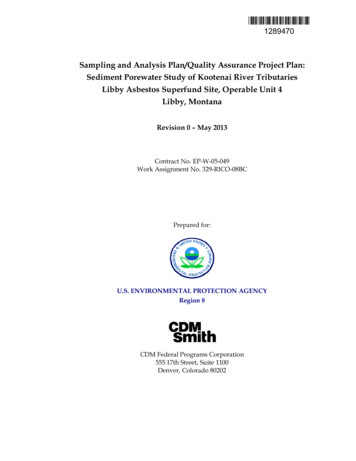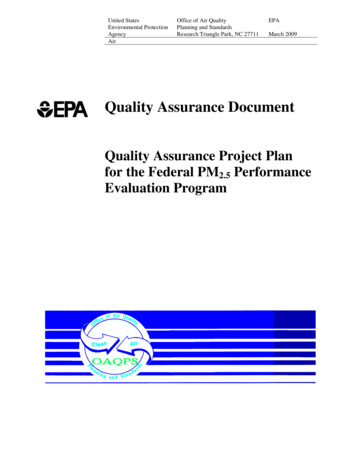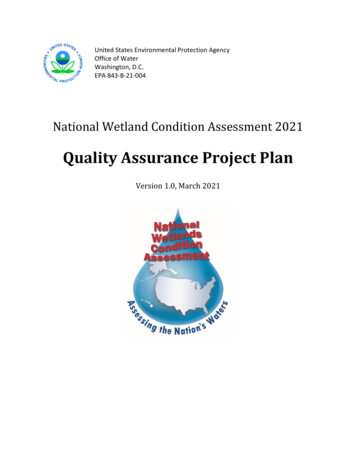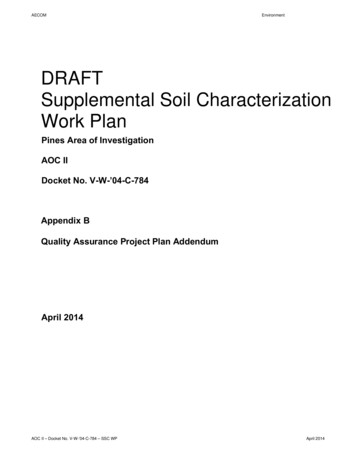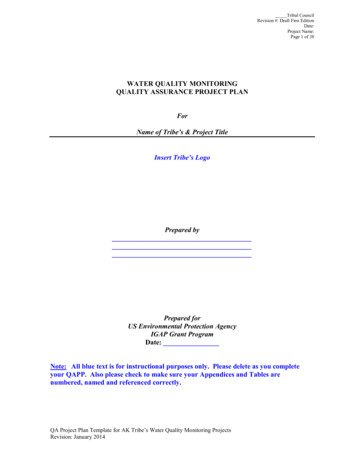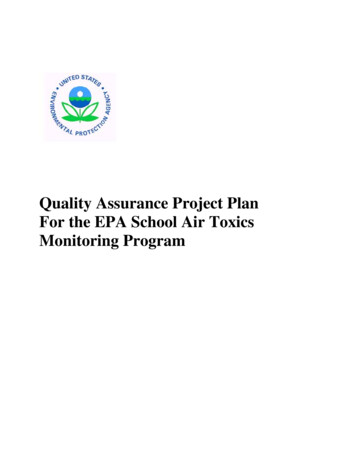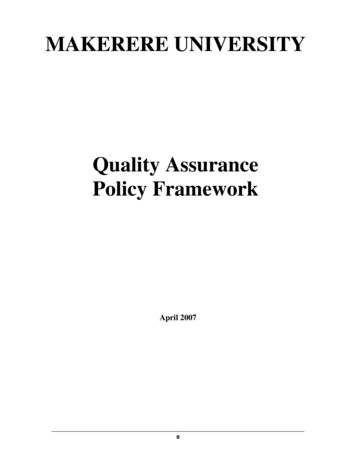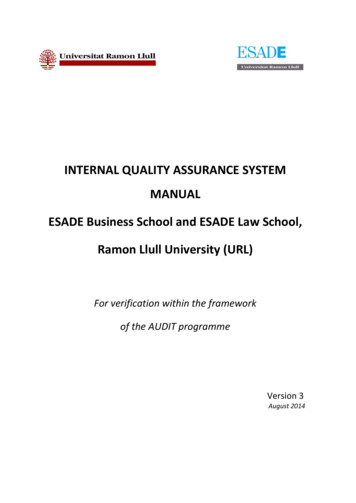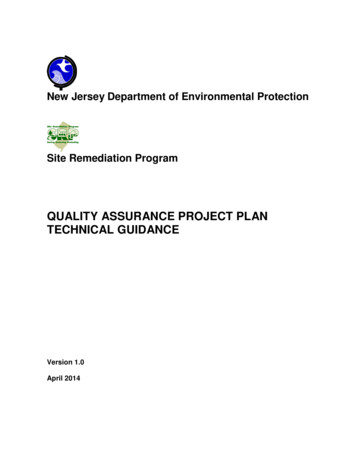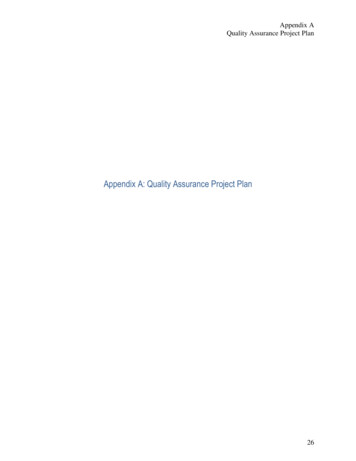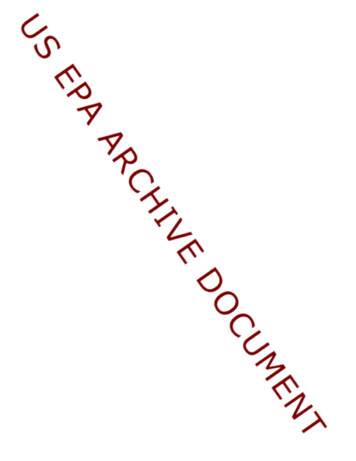
Transcription
Quality Assurance Project Plan (QAPP) Template:Initiatives Exploring the Use ofEnvironmental Management Systems (EMSs) in a Regulatory ContextFunded by EPA State Innovation Grants (SIGs)[REMOVE THESE TWO PAGES BEFORE SUBMITTING.]PURPOSE: This template is intended to help improve the quality assurance (QA) capabilities andunderstanding of State Innovation Grant (SIG) recipients that are undertaking what can be termed "EMSregulatory" initiatives—projects that attempt to integrate the use of environmental management systems(EMSs) into regulatory approaches such as permitting. This template is expected to improve the rigorand consistency of Quality Assurance Project Plans (QAPPs) submitted to EPA and thereby improve bothSIG project design and the quality and usability of the data and analysis resulting from SIG projects. Thedesign of this template is also expected to streamline the QAPP submission and review process,potentially leading to earlier project implementation.BACKGROUND: This QAPP template was prepared based upon review of EPA guidance on QAPPs,sample SIG proposals and QAPPs for initiatives exploring the use of EMSs in a regulatory context, andan existing template for Environmental Results Programs. In its structure, this template adheres closelyto the recommended QAPP review sheet. This structure will help ensure broad applicability and astreamlined review process for EPA Regions and Headquarters. In content, the template provides"boilerplate" language that is likely to be useful for many SIG recipients. However, every project isunique, and you should tailor the text to suit your needs.Please note that this template is not an official EPA document, has not undergone review by all relevantEPA QA specialists, and may be modified in the future based upon such review.ASSUMPTIONS: This template was prepared to meet the needs of a “typical” state EMS-regulatoryprogram. It assumes that participating facilities and the state Agency will reach facility-specificagreements about incentives (like reduced oversight) tied to the implementation of an EMS andsatisfactory improvements in environmental performance. It assumes that the project will not involvestatistical sampling. If your initiative differs in any of these respects, you may need additional guidancebeyond that which is provided in the template.USAGE: Text that is enclosed in square brackets and highlighted in yellow is meant to be changed by theuser. (You might want to change other text as well, depending on the nature of your initiative.)Guidance/advice for particular sections is enclosed in Microsoft Word comments. If you are using aversion of Microsoft Word from 2003 or later, set View to “Print Layout” and comments will appear in theright-hand margin. If you are using an earlier version of Word, you will see the comments when themouse passes over particular flagged passages or in a window at the bottom of the screen. With theseearlier versions of Word (or with other word processors), you might find it easier to view a hardcopy orelectronic copy of the Adobe PDF version of the template, also available from EPA's National Center forEnvironmental Innovation. You may find it helpful to view the hardcopy while editing the electronic text inyour word processor.Hyperlink usage. Depending on your version of Microsoft Word and your user settings, you might beable to access hyperlinked documents and web pages by simultaneously pressing “Ctrl” and right-clickingwith your mouse, or you might need to copy and paste the URL directly into your browser.PRE-SUBMISSION CLEANUP: Before submitting your customized QAPP to EPA, it is recommendedthat you remove yellow highlighting, make sure all bracketed text has been replaced with your own text,
and update the table of contents and lists of tables and/or figures. You may also wish to removeMicrosoft Word comments that you and other readers are not likely to need in the future. Instructions onhow to carry out these tasks are included below. Note that the instructions were developed based oncommands and functions available in Microsoft Word 2003. If you are using a different version ofMicrosoft Word, you may find that the commands in your version are slightly different than the commandsdescribed here.Removing highlighting. To remove all highlighting, first select all text in the document by choosing“Edit/Select All” from the menu. Click on the arrow next to(the highlighting icon) on the toolbar andthen select “None” from the color options available in the pop-up window. (If you do not seeon thetoolbar, make sure that the formatting toolbar is visible by right-clicking anywhere in the toolbar area. If“Formatting” is not selected, click on it.) Highlighting in the header must be taken out separately. Doubleclick on the header, select the highlighted text, and proceed as above.Removing bracketed text. To make sure that all bracketed text has been replaced, use the searchfunction in Microsoft Word, found under “Edit/Find” on the menu. Type “[“ or “]” in the box next to “FindWhat” and then click “Find Next.” Replace any brackets you find and repeat the process until a pop-upwindow appears, indicating that no occurrences of the search term were found. Be sure to check theheader for bracketed text as well.Updating table of contents, etc. To update a table of contents or other reference table (e.g., list offigures), first select the reference table by clicking anywhere on the table. With the table selected, pressthe F9 key. Note that when you update a reference table, any text or formatting that you have added tothe table is lost. Note also that the table of contents and other reference tables are generated based uponthe formatting styles used for the headings for different sections and subsections of this template.Removing comments. To delete all comments from the document, click on the arrow next to(“RejectChange/Delete Comment”) and then click “Delete All Comments in Document.” (If you do not seeonthe toolbar, make sure that the reviewing toolbar is visible by right-clicking anywhere in the toolbar area.If “Reviewing” is not selected, click on it.) To delete an individual comment, right-click on the commentand click "Delete Comment."AMENDING THE QAPP: This template assumes that the QAPP submitted with your proposal/workplanwill not have all of the details you will need before you begin data collection. It assumes that you willamend your QAPP in the future after completion of key planning steps, but before data collection begins.Page 2 of 23
Copy #[Insert State Agency name here][Insert project title here]Quality Assurance Project Plan[Insert Agency name and address here][Insert full contact information for project manager]PLEASE DO NOT PHOTOCOPY THIS DOCUMENTDistribution of this document is controlled in order to avoid having multiple versions of thedocument in circulation. Please see [QA Officer] to obtain additional copies or addindividuals to the distribution list.Abstract: This document details a quality assurance plan to guide the successfulimplementation of [name of project]. [Provide a very brief summary of the project, to orient thereader. Two to three sentences should be sufficient. A more detailed description of the projectwill be given in A6.]Page 3 of 23
QAPP for [Insert Agency name & project title]: Revision R0. August 31, 2005APROJECT MANAGEMENTA1.Approval Sheet[Insert name of project manager][Insert Agency name][Insert title]Date[Insert QA Officer name][Insert Agency name]Quality Assurance OfficerDate[Insert name of partner][Insert organization name][Insert title]Date[Insert name of partner][Insert organization name][Insert title]DatePage 4 of 23
QAPP for [Insert Agency name & project title]: Revision R0. August 31, 2005A2.Table of Contents[Be sure to update table of contents & header.]APROJECT MANAGEMENT .4A1.Approval Sheet.4A2.Table of Contents .5A3.Distribution List.6A4.Project/Task Organization .6A5.Problem Definition/Background.7A6.Project/Task Description .9A7.Quality Objectives and Criteria.11A8.Special Training/Certification.13A9.Documents and Records.14B DATA GENERATION AND ACQUISITION .16B1.Experimental Design .16B2.Sampling/Experimental Methods.16B3.Sample Handling and Custody.17B4.Analytical Methods .17B5.Quality Control (QC).17B6.Instrument/Equipment Testing, Inspection, and Maintenance .18B7.Instrument/Equipment Calibration and Frequency .18B8.Inspection/Acceptance for Supplies and Consumables .18B9.Non-Direct Measurements (I.e., Secondary Data) .19B10. Data Management.20C ASSESSMENT/OVERSIGHT .21C1.Assessment and Response Actions.21C2.Reports to Management.21D DATA REVIEW AND EVALUATION.22D1.Data Review, Verification and Validation Criteria.22D2.Verification and Validation Methods .22D3.Evaluating Data in Terms of User Needs .23List of TablesTable 1: Distribution List .6Table 2: Project Implementation Personnel .6Table 3: Schedule of Major Project Tasks .9Table 4: Secondary Data .19Table 5: Project QA Status Reports.22List of FiguresFigure 1: Project Organizational Chart.7Figure 2: Logic Model .8Page 5 of 23
QAPP for [Insert Agency name & project title]: Revision R0. August 31, 2005A3.Distribution ListThe following individuals will receive a copy of this Quality Assurance Project Plan (QAPP) andany subsequent revisions:Table 1: Distribution ListCopy #C1C2C3C4C5C6NameProject Title orPositionProject ManagerQA OfficerEPA LiaisonContractorPartnerNGO ObserverOrganizational PT/OAffiliationPTPTPTPTPTOContact InformationPT Project team member, O ObserverAdditional copies of the QAPP may be requested from the QA Officer.A4.Project/Task OrganizationPersonnel involved in project implementation are listed in Table 2. Following the table, theresponsibilities of key personnel are enumerated. Lines of authority and communication areshown in the organization chart in Figure 1.Table 2: Project Implementation PersonnelNameRole in Project, Title,Organizational AffiliationPage 6 of 23Contact Information
QAPP for [Insert Agency name & project title]: Revision R0. August 31, 2005The Project Manager will be responsible for the following activities: Conduct outreach with potential participants and stakeholders Oversee participant enrollment, data collection, and data analysis tasks Issue quarterly and annual reports to EPA [Insert other tasks here]The QA Officer will be responsible for the following activities: Maintain QAPP and amend as needed Distribute QAPP and maintain distribution list Conduct readiness reviews [Insert other tasks here][Contractor, if applicable; if a contractor has yet to be selected, say “Contractor to bedetermined”] will be responsible for the following activities: [Insert contractor tasks here, including tasks specifically related to QA/QC][Partner, if applicable; if partner has yet to be identified, say ”Partner to be determined”]will be responsible for the following activities: [Insert partner tasks here, including tasks specifically related to QA/QC; e.g., acommunity group assisting in the identification of the facility universe]Figure 1: Project Organizational Chart[Insert chart. Chart should demonstrate that the QA Officer is independent of the unitsgenerating the data.]A5.Problem Definition/BackgroundRationale for initiating the project[Insert text describing the problem this project is trying to solve]Objectives of the projectThe project is designed to deliver the following short-term, intermediate, and long-termoutcomes, and enable the Agency to make the following decisions.Anticipated outcomes[Examples of anticipated short-term outcomes (changes in awareness and attitudes) mightinclude: Increased awareness of impacts on the environment Improved understanding of opportunities to reduce environmental impactsPage 7 of 23
QAPP for [Insert Agency name & project title]: Revision R0. August 31, 2005 Increased commitment to improve environmental performanceIncreased awareness of the value of EMSsExamples of anticipated intermediate outcomes (changes in behavior) might include: More widespread adoption of EMSs Continuing environmental performance improvement among program participants(including environmental aspects that are currently regulated, as well as those suchas energy and water use that are not traditionally regulated)Examples of anticipated long-term outcomes (changes in conditions) might include: Improvement of environmental quality (environmental conditions may be expected toimprove overall, in a target region or watershed, or in a target community withenvironmental justice concerns). Increased recognition of environmental leaders among key stakeholders (e.g., thepublic, local community members, employees, or investors) Greater efficiency and cost savings for participating facilities More efficient allocation of state Agency resources Cost savings for the state Agency Development of a policy approaches that could be used in other contexts, such asdifferent sectors, environmental media and/or states Improved communication and understanding between regulators and the regulatedcommunity Greater collaboration among state agencies Enhanced networking and peer mentoring within the regulated community]Anticipated decisions[Examples of decisions to be taken based upon data collected might include: Will program incentives be implemented and/or expanded? Should [Agency] continue/discontinue/expand its EMS-regulatory initiative? Based on the experience of this project, how should [Agency] modify the EMSregulatory program? (e.g., what incentives are most effective? Should [Agency]further modify its traditional regulatory approach? How far should [Agency] relaxregulatory oversight of facilities that achieve similar benchmarks?)]The following logic model shows the relationships among project activities and majoroutcomes and decisions.Figure 2: Logic Model[Insert logic model.]Page 8 of 23
QAPP for [Insert Agency name & project title]: Revision R0. August 31, 2005Regulatory information, applicable criteria and action limitsOnly facilities with a satisfactory history of regulatory compliance will be allowed toparticipate in the program. "Satisfactory regulatory compliance" will be defined as [insertcompliance definition here].A6.Project/Task DescriptionProject overview[Insert a short description of the project and how it will meet the objectives described above.This template was developed under the assumption that the project will involve an exploration ofthe use of EMSs in a regulatory context. Most likely you can use language from your StateInnovation Grant proposal/workplan here. You may want to amend this section later as yourefine the goals and measures.]Project summary and work scheduleThis project’s major tasks and timetable are outlined in the table below.Table 3: Schedule of Major Project TasksTask NameOutreach tocandidate facilitiesOutreach tostakeholdersGoalsidentificationDetermination ofcriteria forparticipationRecruitment andenrollmentTask DescriptionStart DatePreliminary outreach to candidate facilities togenerate interest in project participation.Preliminary outreach to stakeholders togenerate interest in observing and/orparticipating in the project.Finalization of project goals, upon whichmetrics will be basedFinalization of criteria used to evaluatewhether candidate facilities are eligible to jointhe EMS-regulatory program.Recruitment and enrollment of candidatefacilities and other stakeholders.Page 9 of 23End Date
QAPP for [Insert Agency name & project title]: Revision R0. August 31, 2005Table 3: Schedule of Major Project TasksTask NameDefinition ofspecific conditionsfor dologyData input &managementstrategyQAPP finalization& approvalInternal trainingBaselinecharacterization[Additionalprogram activities,one per row]Task DescriptionIn the case of each facility, preparation of a“contract” (e.g., a permit or other legallybinding document) agreed upon by thefacility, stakeholders, the state Agency, andEPA, laying out the roles and responsibilitiesof each party. The crucial component isreaching agreement on what goals the facilityundertakes to accomplish and what incentivesthe facility receives in return.Finalization of performance metrics to betracked by this the project. This will includeidentification of metrics/data to be providedby participating facilities.Development of a methodology to driveperformance measurement and analyticaltasks.Development of an approach for collectingand managing project data.Finalization of the QAPP based upon resultsof the measures identification, analyticalmethodology, and data management tasks.Includes process of review and approval byEPA.Training of Agency staff responsible forprogram implementation. The training ofstaff responsible for data collection andanalysis will include a review of the relevantparts of the QAPP.Collection of current/historical data from eachfacility to establish a baseline for performancemeasures and normalization factors. Ifapplicable, aggregation of baseline data fromfacilities to establish project-wide or otherbaselines.Describe additional program activities, suchas EMS implementation and related training,mentoring, reporting, provision of incentives,technical assistance, etc.Page 10 of 23Start DateEnd Date
QAPP for [Insert Agency name & project title]: Revision R0. August 31, 2005Table 3: Schedule of Major Project TasksTask NameFollow-up orscheduled datacollectionData analysisQA ReviewReporting ofresultsTask DescriptionFacility reports, site visits, surveys, etc.Start DateEnd DateAnalysis of baseline, operational, follow-up,and normalization data to understand changein facility performance and overall outcomesof interest. Assessment of project efficiency.Validation and verification of results.Reporting to EPA, participating facilities,other stakeholders, and the general public.Geographic focusFacilities from every part of the state are expected to participate. The actual distribution offacilities will be described in reports that [Agency] prepares on program results.Resource and time constraints[Insert, to best of your knowledge]A7.Quality Objectives and Criteria[Agency] recognizes the importance of ensuring that data are of sufficient quality to meet theneeds of the project. [Agency] is committed to collecting primary data and obtaining secondarydata of the highest quality possible within the constraints of project resources. Data quality canbe characterized in terms of precision, bias, representativeness, completeness, comparability, andsensitivity. These characteristics are termed data quality indicators (DQIs).PrecisionFor environmental measurements, the Agency will [encourage/require] facilities to meet theprecision standards achievable by the use of EPA-approved analytical methods with propersample collection and handling protocol.[Also identify other measures you will take to ensure the precision of various data sets. Forexample: Will facilities be required to document their anticipated, and actual, data collectionmethods? If so, you will have opportunities to intervene to ensure high-quality data, andto judge the quality of data already collected.Page 11 of 23
QAPP for [Insert Agency name & project title]: Revision R0. August 31, 2005 Will the wording of data collection instruments like surveys and reporting forms bereviewed to remove ambiguity? The more precise the wording of the data collectioninstruments, the more confidence one can have in the precision of the responses.Will facilities receive guidance in the form of voluntary or mandatory training sessions?Will facilities be required to certify reports that they submit and face penalties forsubmission of false data? Arguably, a requirement to formally certify could encouragefacilities to QA their data more thoroughly.]Bias[Agency] anticipates the following kinds of bias may impact the ability to draw conclusions fromthe data: [Insert recognized biases here]To reduce concerns about facility self-reporting bias, the Agency will require facility-specificenvironmental performance goals, data collection procedures, and the choice of normalizationfactors to be agreed upon before the facility begins to collect data. In its initial review of thefacility’s performance goals, the Agency will check for signs of potential cross-media transfersor double-counting of environmental improvements. Although facility results will be selfreported, . . . [describe your approach to minimizing the impact of potential self-reporting bias.Will data be maintained in auditable form? Will the Agency or a contractor audit data or inspectdata collection instruments? Will there be random or scheduled site visits? Will the achievementof performance goals be incorporated into EMS reporting? Will non-audited results bedifferentiated from audited results in public reports?]To reduce concerns about bias in the Agency’s own reporting of project results, progress reportsand the final project report will report potential biases in the data and justify all conclusionsreached on the basis of project data, and project data will be open to EPA inspection for [x]years.Representativeness[Describe how the project will optimize the representativeness of samples taken, and minimizethe impact of any unrepresentative data on the analysis.]To ensure representativeness of physical samples, the Agency will review each facility’ssampling plan to ensure that environmental sampling from every medium will be collected inaccordance with guidelines and “best practices” established by the state or EPA.To ensure that facility data are representative of overall facility performance, facilities will berequired to commit to and measure against facility-wide goals, rather than process-specific goals.Completeness[Describe goals for completeness in each important data set. If you wish, specify a minimumreporting rate: E.g., what percentage of data do you expect to collect?]Page 12 of 23
QAPP for [Insert Agency name & project title]: Revision R0. August 31, 2005When data used for analysis are incomplete, the potential impact of their incompleteness on theanalysis will be described in all relevant reports.ComparabilityThe most important comparisons to be made in this project are between baseline data and followup data from individual facilities. For the sake of comparability, in all cases such comparisonswill be normalized. The Agency will work with facilities to ensure that appropriatenormalization factors are chosen.In general, all quantitative comparisons (e.g., among facilities, among industries, acrossprograms) will be normalized whenever appropriate normalization data can be obtained. Ifnormalization is not possible, the Agency will make note of any considerations that would affectconfidence in the comparison. Data from different sources will never be combined unless theywere collected in a comparable manner.[If financial and/or personnel resource data are being collected, provide a description of how youwill ensure comparability for these data.][If your project involves a control group that does not participate in program activities, discussthe criteria you will use to select control facilities (e.g., sector, size, ownership characteristics,location, etc.) to make them as comparable as possible to participating facilities. Since the twogroups can not be perfectly comparable, also explain how you expect that the differences maylimit the conclusions that can be drawn from comparison of the control group and the "treatment"group (i.e., the group of participants).]SensitivityFor environmental measurements, the Agency will [encourage/require] facilities to meet thesensitivity standards achievable by the use of EPA-approved analytical methods with propersample collection and handling protocol.A8.Special Training/CertificationTo the extent practicable, [Agency--and, applicable, insert contractor/partner name] will developand deliver [mandatory/voluntary] training sessions to key parties to ensure quality data.Training will be provided by [Agency/contractor/mentor facilities/non-profit partners] to thefollowing individuals to ensure quality primary data collection: Facility personnel who will be collecting baseline and follow-up dataData-entry personnel who will be processing data from inspections and self-certificationresponsesQA/QC personnel (if any additional training is needed to familiarize them with the project)Page 13 of 23
QAPP for [Insert Agency name & project title]: Revision R0. August 31, 2005Each session will cover proper data collection/handling and QA procedures. Training will beaugmented by debriefing personnel shortly after their tasks have begun, to correct and clarifyappropriate practices. Technical assistance will also be provided to facilities by[Agency/contractor/mentor facilities/non-profit partners].The Project Manager is responsible for ensuring that all personnel involved with data generation(including state personnel, contractors, and partners) have the necessary QA training tosuccessfully complete their tasks and functions. The Project Manager will document attendanceat all training sessions. Attendance records for voluntary trainings may not include names, givenprivacy/confidentiality concerns.A9.Documents and RecordsProject data reporting--format and content[Identify all standardized reports, data collection forms, etc., to be used during the project. Foreach one, specify the format and content.]Reports and forms include:[modify the list below to suit your project] Application form for facilities Facility performance report Audit checklist for [Agency] or third-party auditors Reports analyzing member characteristics, performance commitments, and resultsOther documents/recordsOther documents and records to be produced by the project include:[modify the list below to suit your project] EMS documentation Independent EMS assessments Facility reports to stakeholders Facility permit Enforcement documentation Facility outreach materials Program web site Amended QAPP Readiness reviews Data handling reports Quarterly and annual progress reports to EPA Project final reportPage 14 of 23
QAPP for [Insert Agency name & project title]: Revision R0. August 31, 2005Storage of project informationWhile the project is underway, project information will be stored [in a central filing cabinet atAgency headquarters, and on the Agency’s secure computer network, according to the Agency’sdata management plan/standard policy]. Upon completion of the project, paper records,photographs, and audio-visual material will be retained for [x] years [at Agency headquarters].Electronic records will be stored for [x] years [on the Agency’s main computer network and at asecure off-site location].[If the project will rely on the presence of auditable records or other information that facilitieswill maintain at their own sites, specify what requirem
QAPP for [Insert Agency name & project title]: Revision R0. August 31, 2005 A3. Distribution List The following individuals will receive a copy of this Quality Assurance Project Plan (QAPP) and any subsequent revisions: Table 1: Distribution List Copy # Name Project Title or Position Organizational Affiliation PT/O Contact Information
